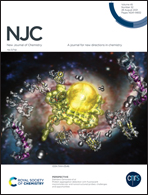Preparation of high-strength and high-toughness biomass medical films based on a polydopamine dynamically united calcium alginate/carboxymethyl chitosan dual network
Abstract
In order to enhance the mechanical properties of a hydrogel film and broaden its applications in the medical field, polydopamine (PDA) was used as the “medium” to construct a dynamically united calcium alginate/carboxymethyl chitosan (CA/CMCS) dual network structure using the Michael addition reaction in this study. A high-strength and high-toughness medical film with a united dual network was prepared by a flow-casting/solvent evaporation method. When the content of sodium alginate (SA)–PDA was 2 wt%, the mechanical properties of the prepared film were the best. The tensile strength and elongation at break were 68.81 Mpa and 3.31%, which increased by 231.61% and 47.77% compared with the CA film. The best comprehensive performance for the medical film could be achieved at the same time. The water absorption rate, maximum swelling rate, water vapor transmission rate, contact angle and degradation rate of the film were 417%, 455%, 1000.45 g m−2 d−1, 55° and 13.13%, respectively. The united dual network structure film had potential applications in the medical field.



 Please wait while we load your content...
Please wait while we load your content...